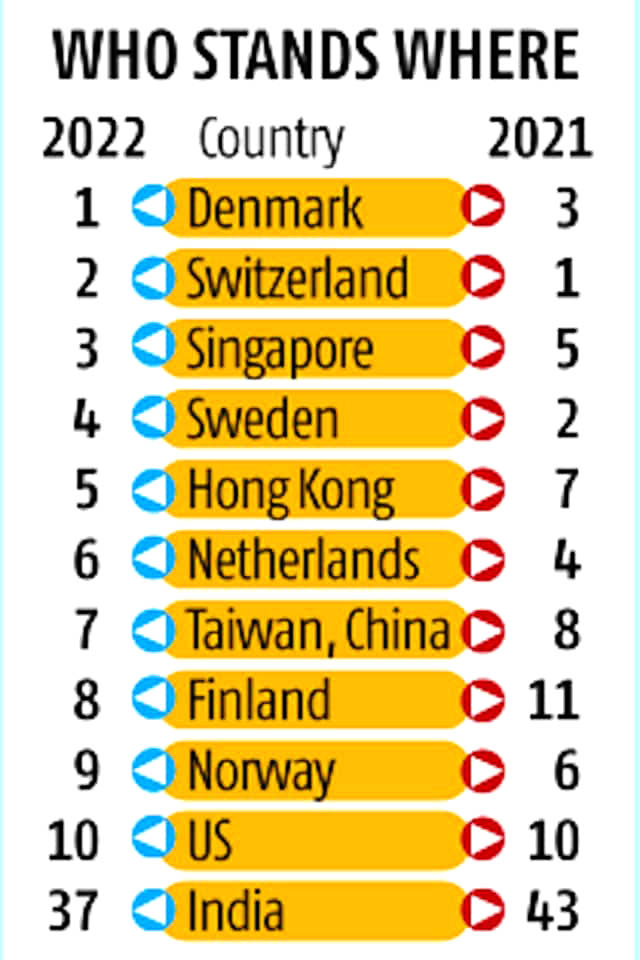World Competitiveness Index 2022 | 17 Jun 2022
For Prelims: World competitiveness Index, Atma Nirbhar Bharat, COP-26
For Mains: Growth and Development, Inclusive Growth
Why in News?
Recently, the annual World Competitiveness Index was released by the Institute for Management Development (IMD).
- IMD is a Swiss foundation, based in Switzerland, dedicated to the development of international business executives at each stage of their careers
- India has witnessed the sharpest rise among the Asian economies, with a six-position jump from 43rd to 37th rank on the, largely due to gains in economic performance.
What is World Competitiveness Index?
- About:
- The IMD World Competitiveness Yearbook (WCY), first published in 1989, is a comprehensive annual report and worldwide reference point on the competitiveness of countries.
- It analyzes and ranks countries according to how they manage their competencies to achieve long-term value creation.
- Factors: It measures the prosperity and competitiveness of countries by examining the Four factors (334 competitiveness criteria):
- Economic performance
- Government efficiency
- Business efficiency
- Infrastructure
What are the Highlights of the Index?
- Top Global Performers:
- Europe: Denmark has moved to the top of the 63-nation list from the third position last year, while Switzerland slipped from the top ranking to the second position and Singapore regained the third spot from fifth.
- Asia: The top-performing Asian economies are Singapore (3th), Hong Kong (5th), Taiwan (7th), China (17th) and Australia (19th).
- Others: Both Russia and Ukraine were not assessed in this year’s edition due to the limited reliability of data collected.
- India’s Performance:
- Performance on four Parameters:
- Economic performance: It has improved from 37th in 2021 to 28th in 2022.
- Government efficiency: It has improved from 46th in 2021 to 45th in 2022.
- Business efficiency: It saw a huge improvement from 32nd rank in 2021 to 23rd in 2022.
- Infrastructure: It on the other hand, saw no change at 49.
- Reasons for India’s Good Performance:
- Major improvements in the context of retrospective taxes in 2021
- Re-regulation of a number of sectors, including drones, space and geo-spatial mapping.
- Significant improvement in the competitiveness of the Indian economy
- India as a driving force in the global movement to fight climate change and India’s pledge of net-zero by 2070 at the COP26 summit also sits in harmony with its strength in environment-related technologies in the ranking.
- India’s Weaknesses:
- The challenges that India faces include managing trade disruptions and energy security, maintaining high GDP growth post the pandemic, skill development and employment generation, asset monetisation and resource mobilisation for infrastructure development.
- India’s Strengths:
- The top five attractive factors of India's economy for business are - a skilled workforce, cost competitiveness, dynamism of the economy, high educational level and open and positive attitudes.
- Performance on four Parameters:
What are the Recent steps taken by India to Increase its Competitiveness?
- Towards Increasing Manufacturing Capacity: India has made appreciable efforts to ensure resilience in manufacturing capacity such as via Atmanirbhar Bharat and Make in India initiatives which are aimed at domestic supply chains and heavy investment in manufacturing hubs.
- The government has introduced the Production-Linked Incentive (PLI) Scheme in various sectors for enhancing India’s manufacturing capabilities and exports.
- Technological Advancement: To facilitate technological advancement for increasing competitiveness, India’s Department of Telecom (DoT) has constituted six task forces on 6G technology.
- The Ministry of External Affairs, through its New, Emerging And Strategic Technologies (NEST) division is also ensuring India’s active participation in international forums on technology governance.
- It acts as the nodal division within the ministry for issues pertaining to new and emerging technologies and assists in collaboration with foreign partners in the field of technology
- The Ministry of External Affairs, through its New, Emerging And Strategic Technologies (NEST) division is also ensuring India’s active participation in international forums on technology governance.
Way Forward
- A nation that ensures balance between economic and social progress can enhance its productivity, followed by creating competitiveness and thus, prosperity.
- Therefore, it is necessary to create an environment which not only pushes the businesses to compete successfully in local as well as international markets but ensures that the average citizen’s standard of living also improves.
- Governments need to provide an environment characterized by efficient infrastructures, institutions and policies that encourage sustainable value creation by the enterprises.
UPSC Civil Services Examination, Previous year Question (PYQ)
Q.Which of the following gives ‘Global Gender Gap Index’ ranking to the countries of the world? (2017)
(a) World Economic Forum
(b) UN Human Rights Council
(c) UN Women
(d) World Health Organization
Ans: (a)
Exp:
- The Global Gender Gap Report is published by the World Economic Forum. The report’s Gender Gap Index, which is designed to measure gender equality ranks countries, according to the calculated gender gap between women and men in four key areas:health, education, economy and politics to gauge the state of gender equality in a country.
- The Global Gender Gap Report 2021 benchmarks 156 countries on their progress towards gender parity across four thematic dimensions: Economic Participation and Opportunity; Educational Attainment, Health and Survival, and Political Empowerment. In addition, this year’s editionstudied skills gender gaps related to Artificial Intelligence (AI).
- India ranks 140th in WEF Gender Gap Index-2021.
- Therefore, option (a) is the correct answer.

